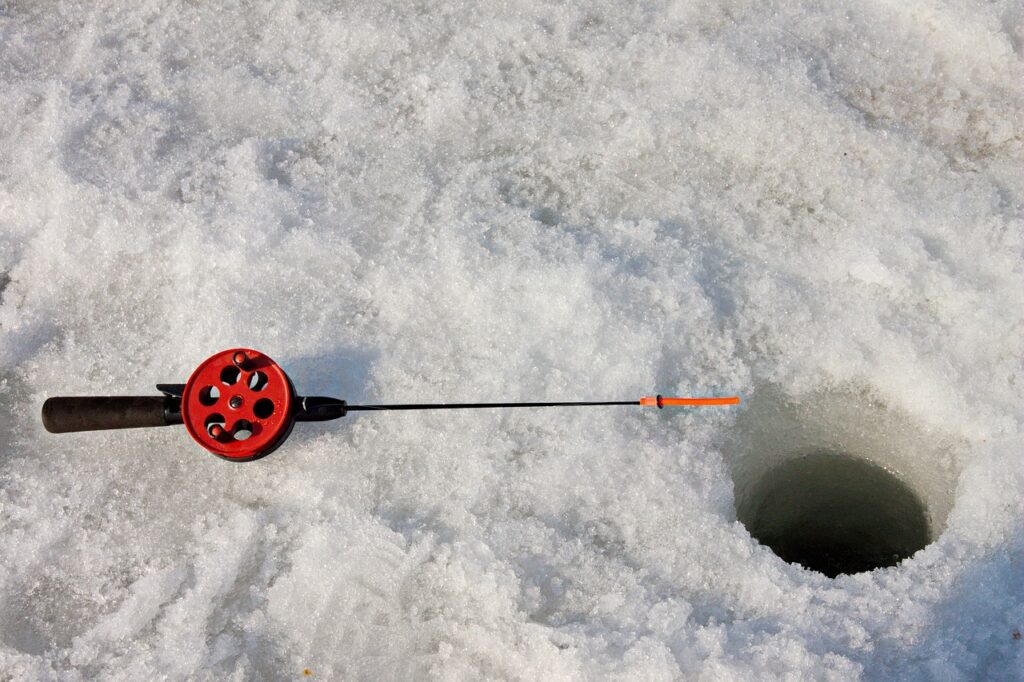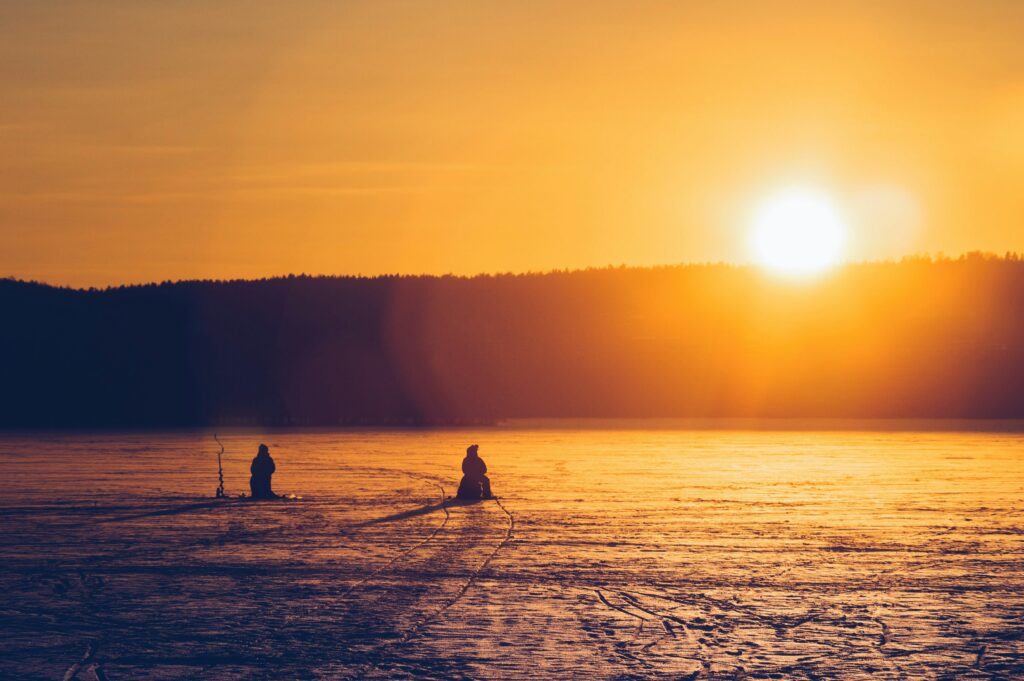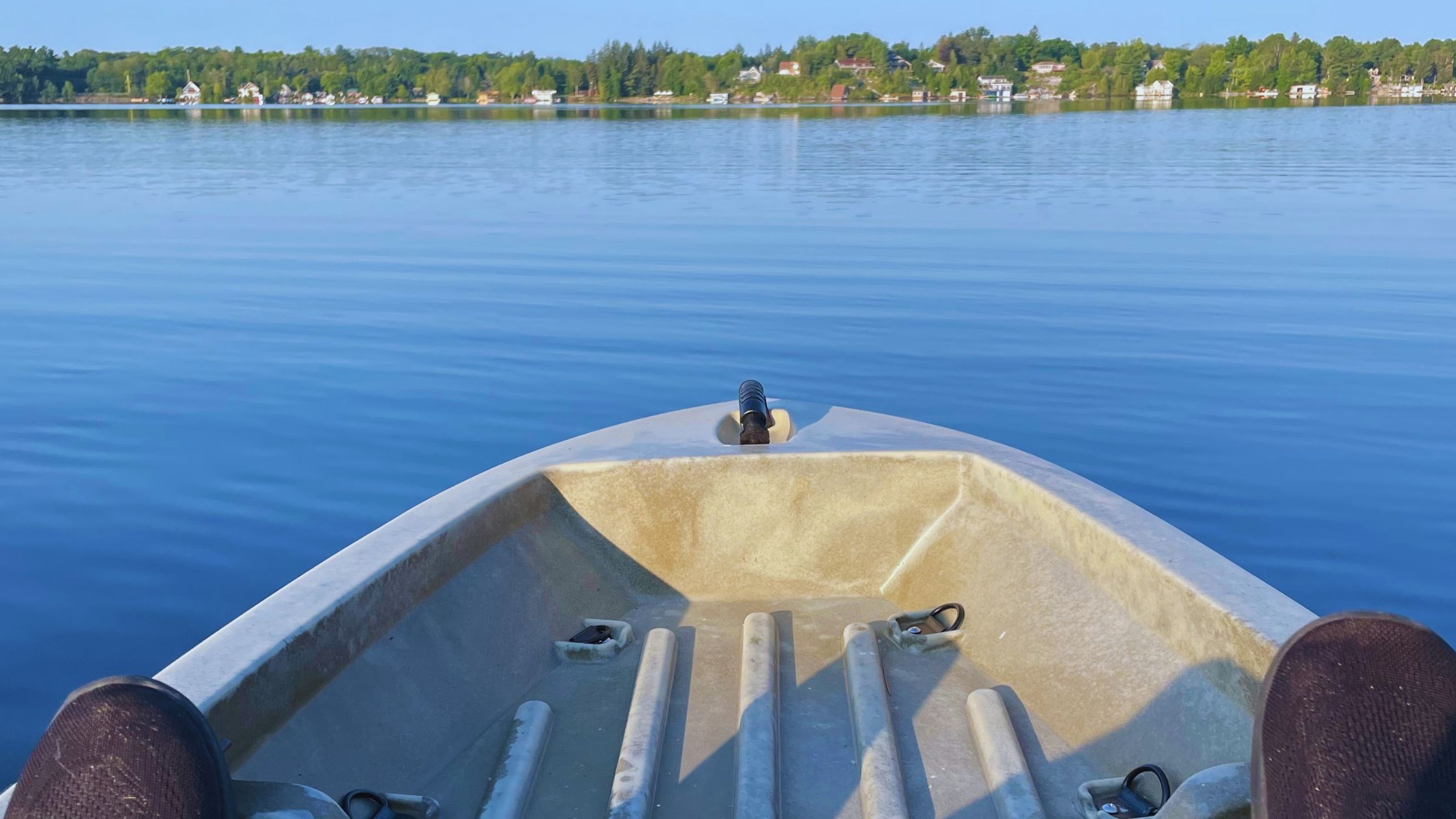Understanding Ice Fishing Environments
When you’re on the ice, the environment is everything. Each ice fishing location, from frozen lakes to remote waterways, has unique conditions that can make or break your fishing trip. If you’re planning your next fishing trip, here are advanced ice fishing tactics to use.
Lake Ice Fishing
Lake ice fishing offers a diverse playground for seasoned anglers targeting a variety of species like pike, crappie, and perch. Clear ice thickness is vital, with a minimum of 4 inches considered safe for ice fishing.
Strategies for Frozen Lakes
- Map out underwater structure before the lake freezes.
- Check snow cover, as it can insulate ice and affect its strength.
Targeting Lake-Specific Species
- Lake trout: Hunt for them around underwater structures.
- Panfish and bluegills: Look for them in shallower areas.
River Ice Fishing
River ice fishing is more unpredictable due to currents. It’s all about navigating river ice conditions safely and knowing where to find pockets of fish.
Navigating River Ice Conditions
Weather plays a significant role in river ice stability; always verify ice integrity during thaws or warm spells.
River-Specific Ice Fishing Tips
- Northern pike: search downstream from points or bends where baitfish might congregate.
- Anglers will often find pike or perch in slower river sections during winter.
Ice Fishing in Remote Locations
Remote locations promise untouched fishing spots. Here, you’re more likely to encounter ice fishing challenges and rewards that are not found in more accessible areas.
Preparing for Wilderness Ice Fishing
- Bring gear suited for extreme conditions, such as high-quality insulated rods.
- Use GPS devices to ensure safe navigation.
Remote Location Species and Tactics
- Target lake trout in deep, isolated pockets.
- For elusive fish like pike, a stealthy approach and strategic placement of baits are essential.
Understanding the ice fishing environment will keep you safe and increase your success in catching the fish you are after. Keep in mind that ice conditions can rapidly change, and always verify safety before heading out. The better you know your fishing environment, the more productive your trip will be.
Advanced Ice Fishing Gear

Equipping yourself with the right gear is essential for a successful and advanced ice fishing experience. From augers to specialized rods and high-tech electronics, every piece of equipment plays a vital role in your fishing efficiency.
Augers and Drills: Cutting Through the Ice
Ice fishing starts with making a hole, and for that, you need a reliable auger. The key is finding one that balances power with portability. Whether you prefer a manual hand auger for its silence or a gasoline-powered model for its speed, this tool is your first step to accessing the fish below.
Choosing the Right Ice Auger
You’ve got options: hand augers, electric augers, and gas augers. Each has its merits. Hand augers, like the StrikeMaster Mora, are quieter and environmentally friendly, ideal for clear water where fish are easily spooked. Gas and electric augers offer more power, cutting through thick ice with less effort.
Efficiently use your auger by clearing slush with each turn, and keep the blades sharp. This helps, especially during cold snaps when the ice thickens quickly.
High-Tech Ice Fishing Electronics
The days of dropping a line and hoping for the best are long gone. Today’s angler uses sophisticated gear like sonar and GPS to turn fishing into a science. These tools don’t replace traditional methods but enhance them.
Using a fish finder with sonar technology allows you to see what’s happening below the ice in real-time. Look for units with flashers, like the Humminbird ICE series, to get an almost immediate reading of fish responses.
A GPS device can be a game-changer on vast icy expanses. Not only can it help you return to productive spots with pinpoint accuracy, but with mapping features, you can track fish habits and terrain changes. Technology like the Garmin ECHOMAP series provides detailed maps and navigational aids.
Specialized Ice Fishing Rods and Reels
Your rod and reel set-up should match the species you’re targeting. Ultra-light rods are perfect for panfish, while heavier gear is needed for the lake’s lunkers. Brands like St. Croix dominate the market for their sensitivity and strength.
Ice rods are shorter to handle the close-quarters combat of ice fishing. For jigging, select a rod that’s sensitive enough to feel the lightest nibble but with enough backbone to set the hook firmly. Pair it with a reel that can handle cold conditions without freezing.
Advanced Techniques with Specialized Gear
Your gear should include a variety of baits and lures, where artificial lures and jigging spoons come into play. The Swedish Pimple is a time-tested jigging spoon that, when used with a subtle technique, can drive fish like walleye and perch to strike aggressively. Don’t forget a spud bar for testing ice thickness and safety!
Remember, a successful ice fishing trip is not just about patience and skill but also about using the right gear effectively. So gear up, get out there, and drill your way to an impressive catch!
Advanced Ice Fishing Techniques

As an experienced angler, you understand that ice fishing is more than just sitting and waiting for a bite. Here, we’ll dig into the nuances of advanced ice fishing techniques that can significantly up your game this winter.
Jigging Mastery
Jigging is an art that requires finesse and patience, especially beneath the ice where fish are more lethargic. A successful jigging technique often involves small, subtle movements to make your bait mimic the natural movements of prey. Remember, the goal is to entice, not startle.
Vertical Jigging Techniques
Vertical jigging demands precision. You’ll want to vary your rhythm and depth until you strike gold. Dropping a jig to the bottom and then raising it slightly can be effective, but experiment—each day on the ice can be different.
Horizontal Jigging for Success
For horizontal jigging, lure choice and color can be game-changers. Consistent motion imitates life—which is irresistible to fish beneath the ice.
Deadsticking: A Subtle Approach
Deadsticking relies on the allure of a static or barely moving bait. It’s perfect when fish are finicky. This technique often uses live bait like minnows, which continue to move and attract predators without much input from you.
Deadstick Setups and Strategies
Equip yourself with a sensitive rod, like the Frostbite Deadstick, that alerts you to the slightest nibbles. Use smaller baits and hooks, as the subtlety of this setup doesn’t pair well with larger presentations.
Remember, patience is not just a virtue; it’s an asset in ice fishing. Observation is key. Watch for any changes in your line tension or rod tip to detect those subtle bites that could lead to your next big catch.
Tip-Up Tactics
Tip-ups are a strategic way to cover more water. Set up tip-ups at various depths and distances from one another to pinpoint where the fish are schooling. It’s like conducting your own underwater surveillance operation.
When setting up your tip-ups, consider the local species’ preferred habitat. For instance, walleye are often found near the bottom in sandy or gravel areas. A baited minnow placed just above the bottom can be irresistible.
Mix up your bait selection to see what the fish are biting on any given day. Live bait tends to perform well, but don’t ignore the appeal of artificial lures that rattle—they can call fish in from afar.
Advanced ice fishing tactics marry technique with innovation. The combination of the right jigging strategy, the perfect deadstick setup, or a well-placed tip-up could make this your most successful season yet. Keep experimenting, stay observant, and maintain that patient finesse, and you’ll see the difference in your haul.
Advanced Ice Fishing Strategies

When you’re seeking the thrill of landing gamefish through the ice, employing advanced tactics can make all the difference. These strategies involve understanding the environment, the behavior of fish, and how the time of day and weather patterns influence their activity.
Location-Based Strategies
Choosing the right location is crucial in ice fishing. You have to consider the body of water, the type of fish you’re targeting, and the presence of structure like underwater weeds, rocky outcrops, or fallen trees. These elements are magnets for fish as they provide shelter and feeding opportunities.
Finding Fish Hotspots
Utilizing a map or GPS can help in identifying hotspots, especially if you have equipment like a Vexilar sonar. It allows you to pinpoint locations where fish are likely to congregate, such as drop-offs or areas with considerable changes in depth. Spotting these areas on a map can lead to a more productive day on the ice.
Seasonal Location Strategies
Shallow waters might be teeming with life at the start of ice fishing season due to higher oxygen levels. As winter progresses, you may find that fish migrate towards deeper areas. Keep in mind that seasonal changes dictate fish location.
Time-of-Day Strategies
Your strategy should vary with the time of day. In the early morning and late afternoon, fish are more active and feed near the surface in shallow waters.
During dawn and dusk, fish like pike and walleye are known to be more active. This makes it an ideal time to set up your tip-ups or jig near the shallow water.
At night, glow lures or jigs can be particularly effective, as fish are drawn to the light. Be extra alert and use your ears; sounds carry well on the ice, and you could hear a tip-up springing to life.
Weather-Driven Tactics
Weather conditions directly impact ice fishing success. A sudden drop in pressure often triggers a feeding frenzy, making pre-storm fishing potentially rewarding.
As an experienced fisherman, you know that adaptability is part of the skill set. Whether it’s a sunny day that warms the shallow water, encouraging pike to hunt, or an overcast sky making crappie less wary, adjusting your approach is key.
Don’t miss the chance when a warm front moves in. This can cause fish to become more aggressive and feed heavily, improving your chances for a successful day. Keep an eye on your forecasts and plan accordingly.
Tailor your strategy, use those tip-ups wisely, and let your fishing prowess shine. Remember, there are no guarantees in fishing, but these refined tactics are your best shot at success.
Staying Safe While Ice Fishing

When you’re out on the ice, your safety is paramount. From understanding the ice’s strength to dressing for success in freezing temperatures, let’s walk through the essential safety measures to keep your ice fishing adventures incident-free.
Ice Safety Essentials
It’s tempting to assume a thick-looking ice surface means game on, but always check ice conditions. Ideally, 4 inches of clear ice is the minimum for fishing on foot, but conditions can vary. Remember, safety is no accident. So, before heading out, contact local authorities or check recent reports from the area you plan to fish.
Ice Thickness and Safety Precautions
Once you’re on the scene, you can’t skate by on guesswork. A cordless drill and a measure is your go-to toolkit. As a rule of thumb, 6 inches supports a snowmobile, and 10 inches can bear a car or small truck—understanding the correlation between ice thickness and weight it can sustain is crucial.
Ice Fishing with Safety Gear
Your gear list must include safety equipment. Wear a life jacket to prevent drowning and use ice cleats for traction. Keep picks readily accessible—they’re your lifeline if you break through. Expert anglers never skimp on these essentials.
Staying Warm and Dry
Layering is your strategy to combat the cold. Start with moisture-wicking base layers and top with insulated pieces. Experts swear by high-quality brands like Patagonia and The North Face for durability and warmth. A waterproof and windproof outer layer keeps you dry and blocks the chill. Don’t forget to protect extremities—your fingers, toes, and nose will thank you.
Emergency Procedures on the Ice
In emergencies, stay calm. If you fall in, use your picks to pull yourself out, then remain flat to distribute your weight until you’re safely off the ice. Keep a charged phone in a waterproof case for help. A stocked first-aid kit is non-negotiable—it should be as essential as your tackle box.
FAQs
Fishing through the ice requires skill and know-how, and these FAQs are designed to give you advanced tips to elevate your ice fishing game. Let’s dive right into your concerns and make this season your most successful one yet.
What Is the Best Time to Use Advanced Ice Fishing Tactics?
To maximize your success on the ice, timing is everything. Studies suggest that ice fishing is usually most fruitful early in the morning or later towards evening, as fish are more active during these times. Implementing advanced techniques like using electronics for locating fish or jigging with precision can give you an edge during these peak hours.
Do I Need Specialized Gear for Advanced Ice Fishing?
Yes, advanced tactics often call for upgraded equipment. A quality fishing rod is essential, and anglers swear by models from reputable brands like HT Enterprises or Frabill for their durability and sensitivity. Don’t forget a reliable tip-up system and an assortment of lures and baits specific to your target species.
What Are the Safety Considerations for Advanced Ice Fishing?
Safety should never be an afterthought when ice fishing. Always verify the ice thickness with a spud bar or auger before settling in. Keep emergency gear on hand, such as ice picks and a floatation device.
Can Beginners Also Benefit from Advanced Ice Fishing Techniques?
Absolutely. Even if you’re new to the ice fishing world, incorporating advanced techniques can yield significant results. Starting with a reliable method like a tip-up can provide a hands-off approach to catching fish while you focus on mastering other skills. Remember that every expert was once a beginner, and with research and practice, you can quickly level up your fishing prowess.
Embark on your next ice-fishing adventure with confidence and a toolkit of advanced strategies. Let your hooks be sharp and your catches plentiful!





